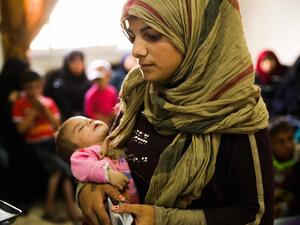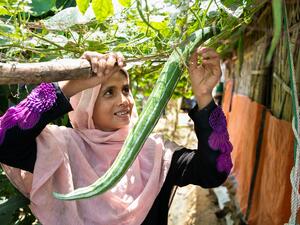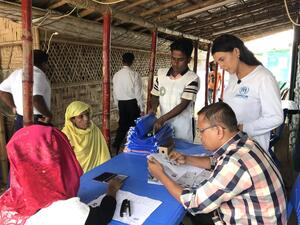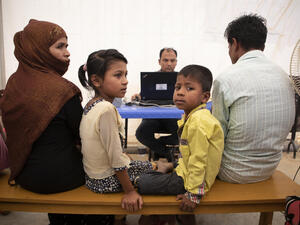Pakistan's census of Afghans provides first detailed profile of the population
Pakistan's census of Afghans provides first detailed profile of the population

Census takers interview Afghans in Lahore in the first quarter of 2005.
ISLAMABAD, August 24 (UNHCR) - An analysis of the information gathered during the census of Afghans in Pakistan by the government earlier this year has revealed a young population whose families arrived mainly in the early years of the conflict in Afghanistan.
The findings are included in a new publication containing the wealth of data gathered about Afghans who were living in Pakistan at the time of the census, which was conducted from February 25 to March 11 by the government of Pakistan with the assistance of the UN refugee agency.
"The census of Afghans, undertaken in all locations in Pakistan, shows that 548,105 Afghan families, constituting 3,049,268 individuals, currently reside in Pakistan. This census presents the clearest quantitative and qualitative demographic data to date on Afghans in Pakistan," says the report on the analysis.
The picture that has emerged shows an Afghan population that has been in Pakistan for many years. Just over half said their families had arrived in 1979 and 1980, the period when the Soviet invasion of Afghanistan triggered the biggest exodus. In fact, 80 percent of all Afghans said their families had arrived by the end of 1985.
"The census also shows a young population," the report said. "Some 19 percent of Afghans in Pakistan are under the age of five, compared to about 14.8 percent of Pakistan's population in this age group."
"This demographic profile underlines the fact that much of the Afghan population was born in exile, and points to the considerable challenge ahead for the Afghan government to ensure sustainable reintegration by providing schools and employment for returnees," it said.
The data is proving a valuable tool as the government of Pakistan and UNHCR press ahead with planning for the management of the Afghan population after the end of the UNHCR voluntary repatriation programme. The current agreement expires in March 2006.
That programme has assisted more than 2.5 million Afghans to return from Pakistan since 2002, including 245,000 so far this year. That suggests there were in excess of 5 million Afghans living in Pakistan at the start of the programme, a higher figure than believed at the time.
However, there had never been a census of Afghans in Pakistan and earlier population estimates did not include the natural population increase from births. In addition population figures were kept only for Afghans in refugee camps, ignoring those living in cities. Assuming an annual 3 percent growth rate, the finding of the census provides a realistic image of the Afghan population in Pakistan over the last 25 years.
There also had been no documentation of the normal population flows across the border, which have increased since the end of the Taliban government. A study earlier this year showed that more than 10,000 people crossed the Torkham border alone in each direction every day. This was reflected in the government's acknowledgement that not all Afghans in Pakistan would be of concern to UNHCR.
A working group that includes the governments of Pakistan and Afghanistan, plus UNHCR, is using the analysis to help in planning a proposed registration next year of all those recorded in the census. The data has provided the most detailed profile ever compiled of Afghans in Pakistan.
By far the largest ethnic Afghan group in Pakistan is Pashtun - nearly 82 percent - as was expected because Pashtun populations live on both sides of the border and because other ethnic groups have returned in larger numbers since the end of the Taliban regime in Kabul in 2001.
Some 62 percent of Afghans live in North West Frontier province with 25 percent in Balochistan, 7 percent in Punjab and 4 percent in Sindh. Some 58 percent of the population were living outside camps while 42 percent were in UNHCR-assisted camps. The census also indicates that 62 percent of the Afghans living in Pakistan originates from six provinces in Afghanistan - 17 percent Nangarhar, 11 percent Kabul, 10 percent Kandahar and 8 percent Kunduz.
Few Afghans have regular jobs. Some 55 percent of households said their livelihood came from daily labour, which may even understate the situation because a further 20 percent described themselves as self-employed. Only 9 percent said they were employed.
More than 17 percent of Afghans told the enumerators they intended to return to Afghanistan during 2005 - a total of 532,000 - which is a bit higher than the 400,000 Afghans that UNHCR predicted would return to Afghanistan during this year.
But the reasons cited for not returning showed a shift from that given by Afghans earlier in the repatriation programme. More that 57 percent said a lack of shelter and access to land in Afghanistan was stopping them from repatriating, with a further 18 percent naming a lack of livelihood opportunities there. The census responses underline the need for continuing development assistance in Afghanistan.
Interestingly, security concerns inside Afghanistan - once the main reason given for not returning from Pakistan - was named by less than 18 percent of all those in the census.

Launching the "Census Report of Afghans living in Pakistan": (from left) Pakistan's Director of Chief Commissionerate of Afghan Refugees Imran Zeb, UNHCR Representative Guenet Guebre-Christos, and States and Frontiers Regions (SAFRON) Secretary Sajid Hussain Chattha.
The census included a wide range of questions including current residence, place of origin, length of stay in Pakistan, livelihood, ethnicity, and intentions to repatriate. It was carried out by 3,143 government staff under the Population and Census Organisation, with UNHCR teams monitoring.
Participation was mandatory for all Afghans who arrived in Pakistan after December 1, 1979, the month in which Soviet troops invaded Afghanistan and triggered a mass exodus of refugees to Pakistan and Iran. Only those who were included in the census will be eligible to be included in a registration, which will provide some form of identification.
By Jack Redden
UNHCR Pakistan









